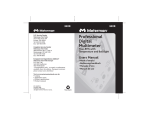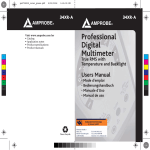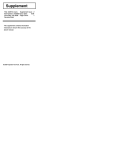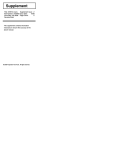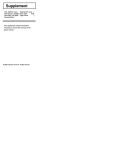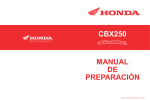Download Amrobe 34XR-A Specifications
Transcript
34XR-A Professional Digital Multimeter Users Manual 99 Washington Street Melrose, MA 02176 Fax 781-665-0780 TestEquipmentDepot.com 34XR-A 1 5 2 MADE IN TAIWAN PATENTS PENDING www.amprobe.com 3 6 ( ) ( ) 4 34XR-A 34XR-A Digital Multimeter Safety Information ...........................................................................................2 Introduction .....................................................................................................3 Making Measurements.....................................................................................3 Verify Instrument Operation..........................................................................3 Range Selection ............................................................................................3 Correcting an Overload (o) Indication .........................................................3 Measuring DC Voltage ........................................... See Figure -1- ...............3 Measuring AC Voltage (True rms)............... See Figures -2- & -3- ...............4 Preparing for Current Measurements............................................................4 Measuring DC Current ........................................... See Figure -4- ...............4 Measuring AC Current (True rms)............... See Figures -3- & -5- ...............4 Measuring Resistance ........................................... See Figure -6- ...............5 Measuring Continuity............................................. See Figure -7- ...............5 Checking Diodes .................................................... See Figure -8- ...............5 Measuring Capacitance ......................................... See Figure -9- ...............5 Measuring Temperature ...................................... See Figure -10- ...............5 Measuring Frequency .......................................... See Figure -11- ...............6 Measuring Dutycycle .......................................... See Figure -12- ...............6 Additional Features ..........................................................................................6 Input Test Lead Warning...............................................................................6 True-rms Measurements ..............................................................................6 MIN MAX Measurements..............................................................................6 Auto Power Off .............................................................................................7 HOLD Measurements....................................................................................7 Backlight .......................................................................................................7 Product Maintenance .......................................................................................7 Battery and Fuse Replacement............................. See Figure -13- ...............7 Repair ..............................................................................................................8 WARRANTY ..................................................................................................9 Specifications ..................................................................................................9 1 Users Manual Contents • • • • • • • • Safety Information The 34XR-A Digital Multimeter is UL, cUL, and EN61010-1 certified for Installation Category III – 600V and Category II – 1000V. It is recommended for use with local level power distribution, appliances, portable equipment, etc, where only smaller transient overvoltages may occur, and not for primary supply lines, overhead lines and cable systems. Do not exceed the maximum overload limits per function (see specifications) nor the limits marked on the instrument itself. Never apply more than 1000V dc/750 V ac rms between the test lead and earth ground. Inspect the DMM, test leads and accessories before every use. Do not use any damaged part. Never ground yourself when taking measurements. Do not touch exposed circuit elements or test probe tips. Do not operate the instrument in an explosive atmosphere. Exercise extreme caution when: measuring voltage >20V // current >10mA // AC power line with inductive loads // AC power line during electrical storms // current, when the fuse blows in a circuit with open circuit voltage >1000 V // servicing CRT equipment. Always measure current in series with the load – NEVER ACROSS a voltage source. Check fuse first. Never replace a fuse with one of a different rating. Remove test leads before opening the Battery Cover or case. Symbols Used in this Manual B T F B P I Battery Double insulated Direct Current Alternating Current Complies with EU directives Fuse 2 W X J R > Refer to the manual Dangerous Voltage Earth Ground Audible tone Underwriters Laboratories, Inc Introduction The 34XR-A is a True rms autoranging handheld digital multimeter for measuring or testing the following: • DC and AC voltage • Temperature • DC and AC current • Capacitance • Resistance • Diodes • Frequency • Continuity • Dutycycle Additional features include: MIN MAX, HOLD, Backlight, and Range Lock Making Measurements Verify Instrument Operation Before attempting to make a measurement, verify that the instrument is operational and the battery is good. If the instrument is not operational, have it repaired before attempting to make a measurement. Range Selection In addition to autoranging the 34XR-A allows you to manually select and lock a range by pressing the RANGE button. RANGE appears on the display to indicate that manual ranging is active. Each subsequent press of the range button steps the meter to the next higher range. When the highest range is reached the next press returns the meter to the lowest range. To return to autoranging press and hold the RANGE button for 2 seconds. RANGE no longer shows on the display. Use autorange for all initial measurements. Then, when appropriate, use the RANGE button to select and lock a range. Warning To avoid electrical shock while manual ranging use the display annunciators to identify the actual range selected. Correcting an Overload (oor -o ) Indication W An o indication may appear on the display to indicate that an overload condition exists. For voltage and current measurements, an overload should be immediately corrected by selecting a higher range. If the highest range setting does not eliminate the overload, interrupt the measurement until the problem is identified and eliminated. The o indication is normal for some functions; for example, resistance, continuity, and diode test. Measuring DC Voltage 1. 2. 3. 4. 5. See Figure -1- Set the Function Switch to v. If RANGE is displayed, press the RANGE button to enable autoranging. Connect the Test Leads: Red to E, Black to COM Connect the Test Probes to the circuit test points. Read the display, and, if necessary, correct any overload (o) conditions. 3 Measuring AC Voltage (True rms) See Figures -2- & -3- See Additional Features to find out the advantages of true rms. 1. 2. 3. 4. 5. Set the Function Switch to V. If RANGE is displayed, press the RANGE button to enable autoranging. Connect the Test Leads: Red to E, Black to COM Connect the Test Probes to the circuit test points Read the display, and, if necessary, correct any overload (o) conditions. Preparing for Current Measurements • • • • • Turn off circuit power before connecting the test probes. Allow the meter to cool between measurements if current measurements approach or exceeds 10 amps. A warning tone sounds if you connect a test lead to a current input before you select a current range. Open circuit voltage at the measurement point must not exceed 1000 V. Always measure current in series with the load. Never measure current across a voltage source. Measuring DC Current 1. 2. 3. 4. 5. 6. 7. 8. See Figure -4- Set the Function Switch to a A function and range. If RANGE is displayed, press the RANGE button to enable autoranging. Connect the Test Leads: Red to µA mA or 10A, Black to COM Turn off power to the circuit being measured. Open the test circuit (X) to establish measurement points. Connect the Test Probes in series with the load. Turn on power to the circuit being measured. Read the display, and, if necessary, correct any overload (o) conditions. Measuring AC Current (True rms) See Figures -3- & -5- See Additional Features to find out the advantages of true rms. 1. Set the Function Switch to a a function and range. 2. If RANGE is displayed, press the RANGE button to enable autoranging. 3. Connect the Test Leads: Red to µA mA or 10A, Black to COM 4. Turn off power to the circuit being measured. 5. Open the test circuit (X) to establish measurement points. 6. Connect the Test Probes in series with the load. 7. Turn on power to the circuit being measured. 8. Read the display, and, if necessary, correct any overload (o) conditions. 4 Measuring Resistance See Figure -6- Set the Function Switch to Ω. If RANGE is displayed, press the RANGE button to enable autoranging. Connect the Test Leads: Red to E, Black to COM Turn off power to the circuit being measured. Never measure resistance across a voltage source or on a powered circuit. 5. Discharge any capacitors that may influence the reading. 6. Connect the Test Probes across the resistance. 7. Read the display. If o appears on the highest range, the resistance is too large to be measured. 1. 2. 3. 4. Measuring Continuity 1. 2. 3. 4. 5. 6. See Figure -7- Set the Function Switch to R. Connect the Test Leads: Red to E, Black to COM Turn off power to the circuit being measured. Discharge any capacitors that may influence the reading. Connect the Test Probes across the resistance. Listen for the tone that indicates continuity (< 35 Ω). Checking Diodes 1. 2. 3. 4. 5. 6. See Figure -8- Set the Function Switch to G. Connect the Test Leads: Red to E, Black to COM Turn off power to the circuit being measured. Free at least one end of the diode from the circuit. Connect the Test Probes across the diode. Read the display. A good diode has a forward voltage drop of about 0.6 V. An open or reverse biased diode will read o. Measuring Capacitance See Figure -9- 1. 2. 3. 4. 5. 6. Set the Function Switch to an appropriate µF function and range. Connect the Test Leads: Red to COM, Black to µA mA P(-) Turn off power to the circuit being measured. Discharge the capacitor using a 100 kΩ resistor. Free at least one end of the capacitor from the circuit. Connect the Test Probes across the capacitor. When measuring an electrolytic capacitor match the test lead polarity to the polarity of the capacitor. 7. Read the display. Measuring Temperature See Figure -10- 1. Set the Function Switch to °C or °F. 2. Connect the K-type thermocouple to a TEMP adapter (XR-TA). Match the polarity of the adapter to the polarity of the thermocouple. 3. Connect the TEMP adapter to the E and COM inputs. Note: The 34XR-A is compatible with all K-type thermocouples. The K-type bead thermocouple supplied with the meter is not intended for contact with liquids or electrical circuits. 4. Expose the thermocouple to the temperature to be measured. 5. Read the display. 5 Measuring Frequency 1. 2. 3. 4. See Figure -11- Set the Function Switch to Hz. Connect the Test Leads: Red to Hz, Black to COM Connect the Test Probes to the signal source. Read the display. The Meter will autorange for the best resolution. Measuring Dutycycle 1. 2. 3. 4. See Figure -12- Set the Function Switch to %. Connect the Test Leads: Red to %, Black to COM Connect the Test Probes to the signal source. Read the display. The Meter will autorange for the best resolution. Additional Features Input Test Lead Warning The meter emits a continuous tone when a test lead is placed in the µA mA or 10A input jack and the Function/Range Switch is not set to a correct current position. (If the meter is connected to a voltage source with leads connected for current, very high current could result). All current ranges are protected by fast acting fuses. True-rms Measurements For ac measurements most DMMs average the ac input signal and display the result as an estimated rms value. This average-responding method is accurate for sinusoidal waveforms, but can be very inaccurate for distorted waveforms. To ensure the most accurate measurements, always use a true-rms DMM when measuring ac voltage or ac current on circuits for the following kinds of applications: • Power Supplies - diodes • Controllers • Power Limiting - SCR or Triac • Starting - motors • Florescent Lighting - ballasts • Speed Control - motors • Pulsed Signals • Any non-sinusoidal ac waveform MIN MAX Measurements The MIN MAX function reads and updates the display to show the maximum or minimum value measured after you press the MIN MAX button. Pressing the MIN MAX button for less than 1 second will put the meter into a mode of displaying the maximum, minimum, or actual readings. Each time the button is pressed, the meter will cycle to the next display mode as shown in the table below. Press the MIN MAX button for more than 2 seconds to exit MIN MAX. Button < 1 second < 1 second < 1 second > 2 seconds Display MAX MIN MIN MAX (blinks) Exit MIN MAX Value Displayed Maximum value after feature activated Minimum value after feature activated Normal measurement, actual reading Normal measurement, actual reading 6 Auto Power Off Auto Power Off is a battery saving feature that puts the meter into a sleep mode if the Function/Range Switch has not changed position in the last 30 minutes. To wake the meter turn it off and then on. The Auto Power Off feature can be disabled to keep the meter from going to sleep. This feature is useful when using the MIN MAX mode for extended periods. To disable the Auto Power Off feature use the following procedure: 1. Set the Function Switch to OFF. 2. Press and hold the MIN MAX button while turning the Function Switch to the desired function. 3. Continue to press the MIN MAX button until the display finishes this initialization period and the reading settles. 4. Release the MIN MAX button. The Auto Power Off feature will remain disabled until the meter is turned off and then on. HOLD Measurements The HOLD button causes the meter to capture and continuously display a measurement reading. To use the HOLD feature make a measurement, and then, after the reading has stabilized, momentarily press the HOLD button. You can remove the test leads and the reading will remain on the display. Pressing the HOLD button again releases the display. Backlight Pressing the L button illuminates the display with a blue backlight. The backlight will automatically turn off in about 60 seconds. Frequent use of the backlight will decrease battery life. Product Maintenance Cleaning To clean the meter, use a soft cloth moistened with water. To avoid damage to the plastic components do not use benzene, alcohol, acetone, ether, paint thinner, lacquer thinner, ketone or other solvents to clean the meter. Troubleshooting If the meter appears to operate improperly, check the following items first. 1. Review the operating instructions to ensure the meter is being used properly. 2. Inspect and test the continuity of the test leads. 3. Make sure the battery is in good condition. The low battery symbol B appears when the battery falls below the level where accuracy is guaranteed. Replace a low-battery immediately. 4. Check the condition of the fuses if the current ranges operate incorrectly. Battery and Fuse Replacement See Figure -13- XWWARNING To avoid electrical shock remove the test leads from both the meter and the test circuit before accessing the battery or the fuses. 7 Specifications General Specifications Display: 3 ¾ digit liquid crystal display (LCD)(3999 count) with a 41-segment analog bar-graph. Polarity: Automatic, positive implied, negative polarity indication. Overrange: (0o) or (-0o) is displayed. Zero: Automatic. Low battery indication: The B is displayed when the battery voltage drops below the operating level. Auto power off: Approx. 30 minutes. Measurement rate: 2 times per second, nominal. Operating environment: 0 °C to 50 °C at <70 % R.H. Storage temperature: -20 °C to 60 °C, 0 to 80 % R.H. with battery removed from meter. Temperature Coefficient: 0.1 × (specified accuracy) per °C. (0 °C to 18 °C, 28 °C to 50 °C). Altitude: 2000 m (6562 feet) Power: Single standard 9-volt battery, NEDA 1604, JIS 006P, IEC 6F22. Battery life: 100 hours typical with carbon-zinc. 200 hours typical with alkaline. Frequent use of the backlight will decrease battery life. Dimensions: 196 mm (H) × 92 mm (W) × 60 mm (D). Weight: Approximately 400 g including battery. Box contents: The 34XR-A includes the following items: Test leads w/ alligator clips 1 set 1 Holster 1 Magnet Strap 1 Temperature Adapter 1 K-type thermocouple 1 Users Manual 1 9 V battery (installed) mA fuse, 0.315 A/ 1000 V 1 spare Approvals: > LISTED 950Z P Safety: Conforms to UL1244; EN61010-1: Cat II - 1000V / Cat III - 600V; Class 2, Pollution degree II. EMC: Conforms to EN61326-1, criteria B This product complies with requirements of the following European Community Directives: 89/ 336/ EEC (Electromagnetic Compatibility) and 73/ 23/ EEC (Low Voltage) as amended by 93/ 68/ EEC (CE Marking). However, electrical noise or intense electromagnetic fields in the vicinity of the equipment may disturb the measurement circuit. Measuring instruments will also respond to unwanted signals that may be present within the measurement circuit. Users should exercise care and take appropriate precautions to avoid misleading results when making measurements in the presence of electronic interference. Electrical Specifications (Accuracy at 23 °C ±5 °C, <75 % relative humidity) DC VOLTS Ranges: 400mV, 4V, 40V, 400V, 1000V Resolution: 100 µV in 400mV range Accuracy: ±(0.5 % rdg + 1 dgt) Input impedance: 400mV: >100 MΩ; 4V: 10 MΩ; 40V to 1000V: 9.1 MΩ Overload protection: 1000 V dc / 750 Vac rms AC VOLTS true rms (45Hz - 2kHz) Ranges: 400m, 4V, 40V, 400V, 750V Resolution: 100 µV Accuracy: ±(1.2 % rdg +8 dgts) 45 Hz to 100 Hz on 400mV range ±(1.2 % rdg + 8 dgts) 45 Hz to 500 Hz ±(2.0 % rdg +8 dgts) 500 Hz to 2 kHz ±(2.0 % rdg + 8 dgts) 45 Hz to 1 kHz on 750 V range Crest Factor: ≤ 3 Input impedance: 400mV: >100 MΩ; 4V: 10 MΩ; 40V to 1000V: 9.1 MΩ AC coupled true rms specified from 5 % to 100 % of range Overload protection: 1000 V dc or 750 V ac rms DC CURRENT Ranges: 400µA, 4000µA, 40mA, 300mA, 10A Resolution: 0.1µA Accuracy: ±(1.0 % rdg + 1 dgt) on 400µA to 300mA ranges ±(2.0 % rdg + 3 dgts) on 10A range Burden voltage: 400 µA Range: 1 mV/ 1 µA 4 mA Range: 500 mV/ 1 mA 40 mA Range: 10 mV/ 1 mA 300 mA: 8 mV/ 1 mA 10A: 40 mV/ 1 A Input protection: 0.315A/1000V fast blow ceramic fuse 6.3×32mm on µA/mA input 10A/1000V fast blow ceramic fuse 10×38mm on 10A input 10A input: 10 A for 5 minutes maximum followed by a 10 minute cooling period AC CURRENT true rms (45Hz - 1kHz) Ranges: 400µA, 4000µA, 40mA, 300mA, 10A Resolution: 0.1 µA Accuracy: ±(1.5 % rdg + 8 dgts) on 400µA to 300mA ranges ±(2.5 % rdg + 10 dgts) on 10A range Crest Factor: ≤ 3 Burden Voltage: See DC Current Input protection: 0.315A/1000V fast blow ceramic fuse 6.3×32mm on µA/mA input 10A/1000V fast blow ceramic fuse 10×38mm on 10A input 10A input: 10 A for 4 minutes maximum followed by a 12 minute cooling period 10 RESISTANCE DUTY CYCLE Ranges: 400Ω, 4kΩ, 40kΩ, 400kΩ, 4MΩ, 40MΩ Resolution: 100 mΩ Accuracy: ±(1.0 % rdg + 4 dgts) on 400Ω to 4MΩ ranges ±(2.0 % rdg + 5 dgts) on 40MΩ range Open circuit volts: -0.45 V dc typical, (-1.2 V dc on 400Ω range) Overload protection: 1000 V dc or 750 V ac rms Ranges: 0 to 90 % Resolution: 0.1 % Pulse widh: >10 µs Frequency range: 40 Hz to 20 kHz Accuracy: (5V logic ) ±(2.0% rdg + 5 dgts) Overload protection: 1000 V dc or 750 V ac rms CONTINUITY Audible indication: < 35 Ω Response time: 100 ms Overload protection:1000 V dc or 750 V ac rms CAPACITANCE Ranges: 4µF, 40µF, 400µF, 4000µF Resolution: 1 nF Accuracy: ±(5.0 % rdg + 10 dgts) on 4µF range ±(5.0 % rdg + 5 dgts) on 40µF to 400µF ranges ±(5.0 % rdg + 15 dgts) on 4000µF range Test voltange: < 3.0 V Test Frequency: 25Hz Input protection: 0.315A/1000V fast blow ceramic fuse 6.3×32mm on µA/mA input DIODE TEST Test current: approximately 1.2 mA Accuracy: ±(1.5 % rdg + 3 dgts) Resolution: 1 mV Open circuit volts: 3.0 V dc typical Overload protection: 1000 V dc or 750 V ac rms ADDITIONAL FEATURES µA mA, 10A Test Lead Connection: Beeps TEMPERATURE Ranges: -20 °C to 1000 °C, -4 °F to 1832 °F Resolution: 1 °C, 1 °F Accuracy: ±(2.0 % rdg + 4 °C) -20 °C to 10 °C ±(1.0 % rdg + 3 °C) 10 °C to 200 °C ±(3.0 % rdg + 2 °C) 200 °C to 1000 °C ±(2.0 % rdg + 8 °F) -4 °F to 50 °F ±(1.0 % rdg + 6 °F) 50 °F to 400 °F ±(3.0 % rdg + 4 °F) 400 °F to 1832 °F Overload protection: 1000 V dc or 750 V ac rms FREQUENCY Ranges: 4k, 40k, 400k, 4M, 40MHz Resolution: 1 Hz Accuracy: ±(0.1 % rdg + 3 dgts) Sensitivity: 10 Hz to 4 MHz: >1.5 V ac rms; 4 MHz to 40 MHz: >2 V ac rms, <5 V ac rms Minimum pulse width: > 25 ns Duty cycle limits: > 30 % and < 70 % Overload protection: 1000 V dc or 750 V ac rms 11 to warn test leads are connected to measure current while Function/Range Switch is not set to a measure current. MIN MAX: Displays the minimum or maximum value detected while making a measurement. HOLD: Holds the latest reading on the display. RANGE: Manual range mode. Backlight: Backlight auto-off approximately 60 seconds Auto Power off: 30 minutes, typical REPLACEMENT PARTS TL36 Test Lead Set with Alligator clips FP300 mA fuse - Fuse Pack .315A/1000V (4 each) FP100 10A fuse - Fuse Pack 10A/1000V (2 each) XR-TA Input Adapter for K-type thermocouple TP255 K type thermocouple ® XR-H2 Magne-Grip Holster, clip, magnet, and strap 1 V 34XR-A 4 5 2 1 % 3 ( ) ( ) 2 V 34XR-A 4 5 2 1 3 ( ) ( ) 12 Input Waveform Signal d'entrée Eingangsschwingungsform Forma d'onda d'ingresso Forma de onda de entrada Sine Wave Sinusoïdale Sinusschwingung Onda sinusoidale Onda sinusoidal Full Wave, Sine Wave Onde complète, Sinusoïdale Volle Schwingung, Sinusschwingung Onda sinusoidale, onda intera Onda completa, Onda sinusoidal Half-Wave, Sine Wave Demi-onde, sinusoïdale Halbschwingung, Sinusschwingung Onda sinusoidale, semionda Media onda, onda sinusoidal Square Wave Onde carrée Rechteckschwingung Onda quadra Onda cuadrada Square Wave Onde carrée Rechteckschwingung Onda quadra Onda cuadrada Pulse Wave Onde impulsionnelle Impulsschwingung Onda delI'impulso Onda de impulsos Sawtooth Wave Onde en dent de scie Sägezahnschwingung Onda a denti di sega Onda diente de sierra 13 34XR-A 4 A 34XR-A 8 4 2 7 5 1 6 3 ( ) ( ) 5 A 34XR-A 8 4 2 7 5 1 % 3 6 ( ) ( ) 14 6 7 34XR-A 5 4 2 6 1 3 ( ) ( ) 7 34XR-A 5 1 3 2 ( ) ( ) 4 6 15 8 3 6 34XR-A 4 1 5 2 ( ) ( ) 9 7 34XR-A 1 6 3 ( ) ( ) 4 2 5 16 10 5 4 34XR-A 1 2 K 3 ( ) ( ) 11 4 3 34XR-A 1 2 ( ) ( ) 17 12 4 34XR-A 1 2 ( ) 3 ( ) 13 (2) (2) 18 (4)




















